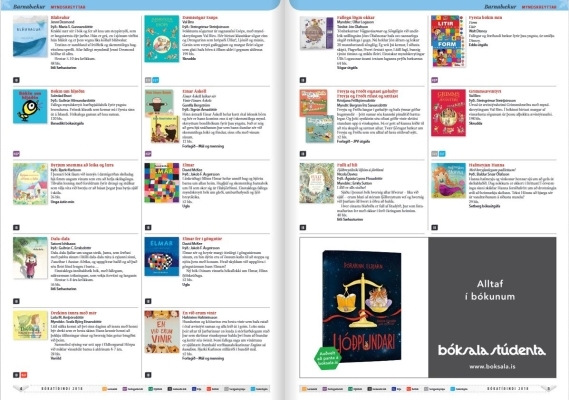From Ambassador
2018/11/30
The Icelandic people‘s passion for reading and publishing


From left to right) The front page of the book catalogue, Inside the catalogue

Piled up books in a bookstore©Art Bicnick
As Christmas time approaches, I can strongly feel the Icelandic people‘s love for reading. Books are the most popular gift to give at Christmas and I have read that the Icelandic people give 2.1 books and receive 1.1 books on average at this time of year.
As a matter of fact, about one to two months prior to Christmas, most households receive a thick “Book Catalogue” which lists hundreds of books that were published that year. A discussion follows between family and friends about which books they want to read this year.
According to the statistical data, the average annual number of book titles read per person is 11.5 books and the number of each household‘s collection of books is one of the highest in the world. And furthermore, Icelandic people don’t only read the books but many are writers as well. It is said that one in ten people in Iceland will publish a book during their lifetime and the most recent number of book titles published per year is around 1600 (for a country of 350,000 people!).
Of course, many titles are published by professional authors, but the number of autobiographies and biographies written by ordinary people are in no small numbers as well. It seems that the emergence of electronic media such as the Internet has not negatively affected their passion for reading and publishing books.
But where does the passion come from in the first place? There must be various possible explanations, but I assume that the biggest reason is that the tradition of narration and documentation, such as the Icelandic Sagas, has been passed down from generation to generation.
Especially with the severe Icelandic winters and the extremely short days, which average around 4 hours, standard family activities, such as members gathering around a fireplace, the mother knitting and the father telling stories to children, have been passed down for over a thousand years. And like this, its narrative skills and reading habits have presumably been passed down to the present households naturally.
Having said all this, I think opportunities for most Japanese people to be exposed to books written by Icelandic authors are still quite limited.
Classical literatures, such as children’s stories and adventure novels by Jón Sveinsson, who is famous for the “Nonni” series, and “Independent People” by Halldór Laxness, who won the 1955 Nobel Prize in Literature and so forth, might be comparatively familiar to Japanese people, but I strongly encourage the Japanese people to read mystery novels by Icelandic authors such as Arnaldur Indriðason. His books have been highly acclaimed internationally in recent years and some of his works have been translated into Japanese.
On the other hand, when it comes to Japanese authors, Yukio Mishima and Haruki Murakami are well known in terms of name recognition and popularity in Iceland. One of the things which surprised me the most recently is that when I dined with an Icelandic political leader who is a known book lover, she told me that she was reading a crime novel by Keigo Higashino.
I presumed that she was reading the book in English but I was pleasantly surprised to find that the book had been translated into Icelandic, when I visited a book store. I got a confirmation of Icelandic people‘s passion for reading and publishing once again!
